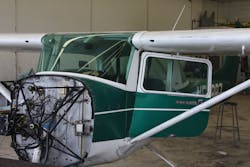As the general aviation aircraft fleet ages, mechanics, and IAs especially, are increasingly faced with the question whether the aircraft in their shop is just too old for them to properly inspect and sign off. Many of these aircraft are not just up there in decades – 30, 40, and 50 years is not uncommon any more – but have also suffered from the economic slump that hit aviation especially hard after 9/11 and has kept many GA pilots, and their aircraft, grounded for long periods of time. (When I talk about aging aircraft in this article, I’m not talking about the meticulously maintained aircraft of collectors.)
The combination of an aging aircraft that has sat for long periods of time presents a particular challenge to mechanics, especially IAs signing off on annual or 100-hour inspections. Where and how the aircraft has been stored can be critical to the condition of the aircraft but difficult to discern from the aircraft records or even from a detailed inspection. Problems caused by humidity or salt air or snow and ice might be hidden and difficult to find even with an in-depth inspection. Add to that an aircraft’s age and the problems for a mechanic trying to do these inspections are compounded.
What’s a mechanic to do?
At the same time that inspecting these aircraft can be a challenge for mechanics, those inspections may also be their bread and butter. A lot of mechanics’ economic survival depends on keeping these old birds in the air. So what’s a mechanic to do? Saying no to an aging aircraft may mean the loss of significant revenue for the airman. At the same time, taking on an aircraft with age-related issues can mean putting the mechanic’s license at risk if an incident or an accident occurs and the FAA determines that the mechanic missed something during, say, an annual inspection. The cost of fighting the FAA or surrendering your A&P for a suspension can both be expensive choices that an airman may be able to avoid by realistically reviewing a few key factors before agreeing to maintain an old aircraft.
- Does the general condition of the aircraft jive with the aircraft records? In other words, does it look like the prior work done on the aircraft was properly recorded, inspections were timely, ADs properly accomplished?
- Do the flight logs indicate long periods of time on the ground over a long period of time? If so, ask how the aircraft was housed during those periods. Take the time to look at the climactic conditions in that area during the time period the aircraft was on the ground.
- Can you realistically charge for the time it will take to completely and thoroughly comply with Appendix D of FAR 43, given the age and condition of the aircraft? If you can’t, the tendency is often to take short cuts; aging aircraft can be much less forgiving of those short cuts.
These might not be bad questions to ask any time you do an inspection.
About the Author

John Goglia
John Goglia has 40+ years experience in the aviation industry. He was the first NTSB member to hold an FAA aircraft mechanic's certificate. He can be reached at [email protected].
John Goglia is an independent aviation safety consultant and Adjunct Professor at Vaughn College of Aeronautics and Technology and regular monthly columnist for four aviation trade publications. He was an airline mechanic for more than 30 years. He has co-authored two text books (Safety Management Systems in Aviation, Ashgate Publishing 2009 and Implementation of Safety Management Systems in Aviation, Ashgate Publishing 2011).
